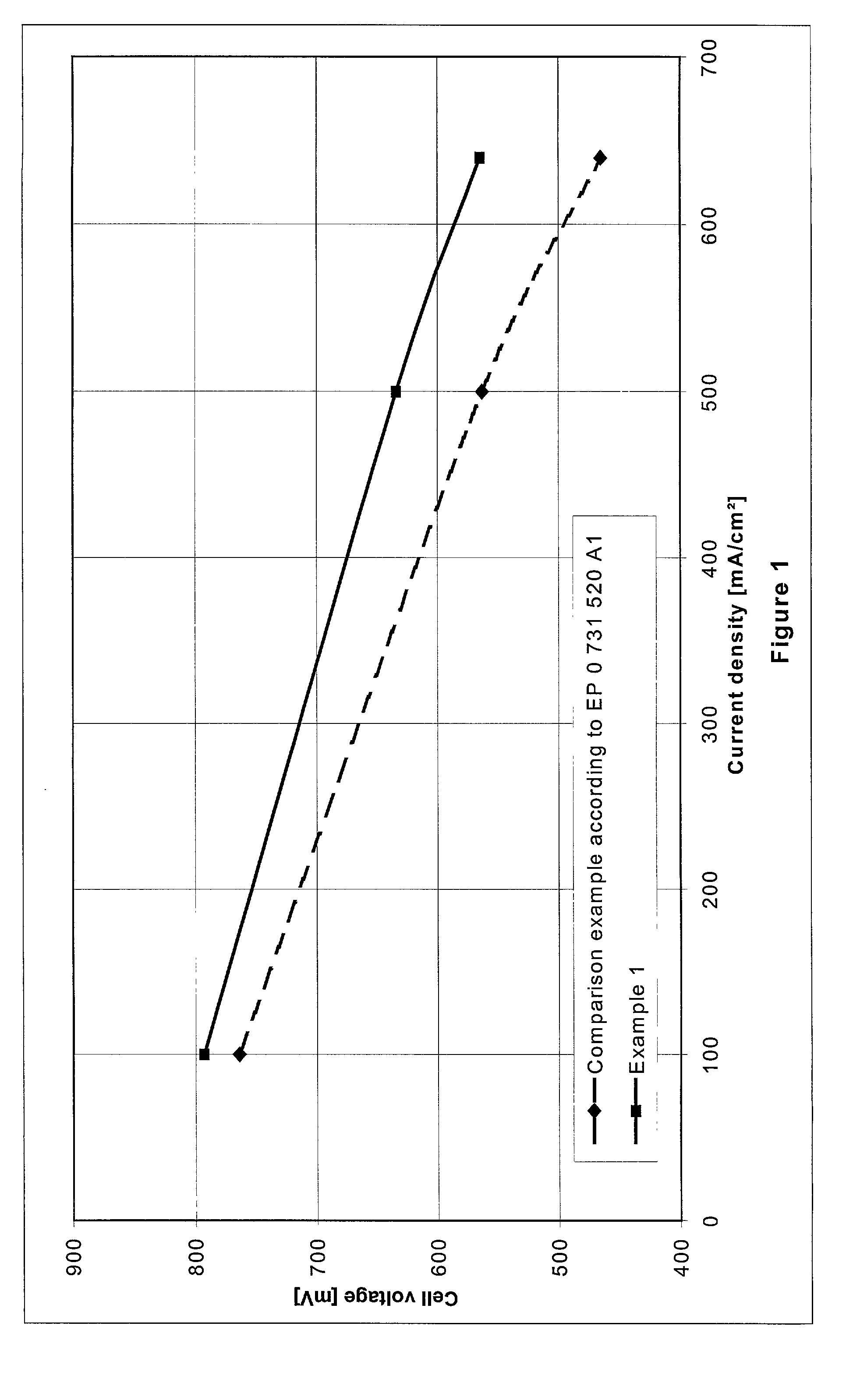Ink for producing membrane electrode assemblies for fuel cells
a fuel cell and membrane electrode technology, applied in the direction of fuel cells, electrochemical generators, electrical equipment, etc., can solve the problems of unsatisfactory so-called "screen life" during which screen printing is possible, affecting the production efficiency of fuel cells, and requiring a very long activation and conditioning period before acceptable electrical performance, etc., to achieve long screen life and high production safety
- Summary
- Abstract
- Description
- Claims
- Application Information
AI Technical Summary
Benefits of technology
Problems solved by technology
Method used
Image
Examples
example 1
[0038] Differently from comparison example 1, the amount of water was reduced to 27 g and replaced by 8 g of dipropylene glycol in accordance with the invention:
3 15.0 g Pt supported catalyst (40% Pt / C, dmc.sup.2) 50.0 g Nafion .RTM. solution (10% in water) 27.0 g water (fully deionized) 8.0 g dipropylene glycol 100.0 g
[0039] The ratio by weight of catalyst to Nafion.RTM. was 3:1. The proportion of dipropylene glycol was 11 wt. % (with respect to the total water content). The ink was applied to the anode and cathode sides of the ionomer membrane Nafion.RTM. 112 as described in comparison example 1. Adhesion of the electrode layers to the membrane after drying and humidifying with water was very good, no peeling of the layers was observed. The total Pt loading was 0.6 mg Pt / cm.sup.2. The MEA produced in this way was measured in the PEM single cell test. At a current density of 500 mA / cm.sup.2 a cell voltage of 634 mV was measured. This value was about 70 mV above the cell voltage in ...
example 2
[0040] The following components were homogenized:
4 15.0 g PtRu supported catalyst (40% PtRu / C: 26.4% Pt, 13.6% Ru; catalyst according to US 6,007,934) 60.0 g Nafion .RTM. solution (10% in water) 15.0 g water (fully deionized) 10.0 g ethylene glycol 100.0 g
[0041] The ratio by weight of catalyst to Nafion.RTM. was 2.5:1. The proportion of ethylene glycol was 14.5 wt. % (with respect to the total water content). The ink was applied to the anode side of an ionomer membrane (Nafion.RTM. 112, DuPont) and then dried at 80.degree. C. Then the ink according to the invention from example 1 was applied to the rear side of the membrane (cathode side) and again dried. After drying, the MEA was moistened with water and then placed moist between two gas distributor substrates. Adhesion of the catalyst layers to the membrane was very good. Measurements were performed in the PEM single cell operating with hydrogen / air. At 500 mA / cm.sup.2 a cell voltage of 620 mV was measured. The MEA also had very g...
example 3
[0042] Another ink was prepared, with the following composition:
5 15.0 g Pt supported catalyst (40% Pt / C, dmc.sup.2) 50.0 g Nafion .RTM. solution (10% in water) 20.0 g water (fully deionized) 15.0 g diethylene glycol 100.0 g
[0043] The ratio of catalyst to Nafion.RTM. was 3:1. The proportion of diethylene glycol was 23 wt. % (with respect to total water content). The ink was applied to the front and rear sides of an ionomer membrane (thickness 30 .mu.m). Adhesion of the catalyst layers after drying and humidification with water was very good. The performance in a PEM single cell operating with hydrogen / air was 650 mV with a current density of 500 mA / cm.sup.2.
PUM
 Login to View More
Login to View More Abstract
Description
Claims
Application Information
 Login to View More
Login to View More - R&D
- Intellectual Property
- Life Sciences
- Materials
- Tech Scout
- Unparalleled Data Quality
- Higher Quality Content
- 60% Fewer Hallucinations
Browse by: Latest US Patents, China's latest patents, Technical Efficacy Thesaurus, Application Domain, Technology Topic, Popular Technical Reports.
© 2025 PatSnap. All rights reserved.Legal|Privacy policy|Modern Slavery Act Transparency Statement|Sitemap|About US| Contact US: help@patsnap.com

